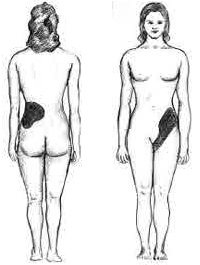Kidney stone disease
The English used in this article or section may not be easy for everybody to understand. (August 2023) |
Kidney stone disease, also known as nephrolithiasis or urolithiasis, is when a solid piece of material (kidney stones, also known as renal calculi) forms in the kidney or bladder. From there, most travel down the urinary tract.[1] Kidney stones typically form in the kidney and leave the body during urination.[1] A small stone may pass without causing symptoms (90% or more) within 3 months.[1] Kidney and bladder stones have been known to be fatal. A US founding father, Benjamin Franklin, had kidney stones.
| Kidney stone disease | |
|---|---|
| Other names | Urolithiasis, kidney stone, renal calculus, nephrolith, kidney stone disease, |
 | |
| A kidney stone, 8 millimeters (0.3 in) in diameter | |
| Medical specialty | Urology, nephrology |
| Symptoms | Severe pain in the lower back or abdomen, blood in the urine, vomiting, nausea[1] |
| Causes | Genetic and environmental factors[1] |
| Diagnostic method | Based on symptoms, urine testing, medical imaging[1] |
| Differential diagnosis | Abdominal aortic aneurysm, diverticulitis, appendicitis, pyelonephritis[2] |
| Prevention | Drinking fluids such that more than two liters of urine are produced per day |
| Treatment | Pain medication, extracorporeal shock wave lithotripsy, ureteroscopy, percutaneous nephrolithotomy[1] |
| Frequency | 22.1 million (2015) |
| Deaths | 16,100 (2015) |

If a stone grows to more than 5 millimeters (0.2 in) it can cause blockage of the ureter resulting in severe pain in the lower back or abdomen.[1][3] A kidney stone 1cm or larger cannot pass on its own and requires surgery.
The medical name for kidney stone pain is renal colic. A stone may also result in blood in the urine, vomiting, or painful urination.[1] About 50% of people who get kidney stones will have another within 5 years, especially if they are under the age of 25.
References
change- ↑ 1.0 1.1 1.2 1.3 1.4 1.5 1.6 1.7 1.8 "Kidney Stones in Adults". February 2013. Archived from the original on 11 May 2015. Retrieved 22 May 2015.
- ↑ Knoll T, Pearle MS (2012). Clinical Management of Urolithiasis. Springer Science & Business Media. p. 21. ISBN 9783642287329. Archived from the original on 8 September 2017.
- ↑ Miller, NL; Lingeman, JE (2007). "Management of kidney stones" (PDF). BMJ. 334 (7591): 468–72. doi:10.1136/bmj.39113.480185.80. PMC 1808123. PMID 17332586. Archived (PDF) from the original on 27 December 2010.